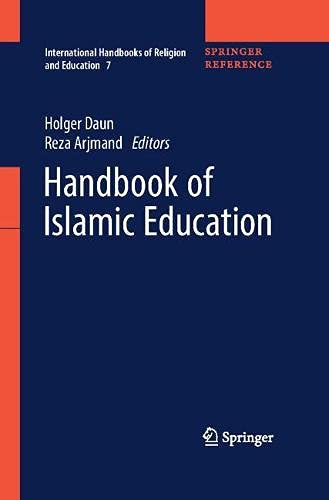آموزش اسلام در انگلستان
Islamic Education in England
- ج.مارک هالستید
- J. Mark Halstead
- چکیده
The first part of the chapter examines the public education system in England and the Muslim response to this system. The dual system of education means that about a third of state-funded schools are owned and operated by religious bodies (mainly the Church of England and the Catholic Church), but the remaining twothirds are not fully secular as they are required by law to teach religious education and provide a compulsory daily act of collective worship. Trends toward equality of provision over the last 40 years have resulted in (a) the widespread abandonment of single-sex education, (b) the spread of comprehensive education which involves the education of children of all abilities in the same establishment, and (c) the growth of multicultural education which seeks to meet the needs of children from different cultural, religious, and ethnic backgrounds and to prepare all children for life in a pluralist society. Although there has been a backlash against multicultural education in some quarters in the last 10 years, it has made state-funded education in England more Muslim-friendly in a number of ways. Religious education is no longer concerned with Christian nurture but adopts a world religions approach, with Islam as one of six religions studied. Ḥalāl food is provided for school dinners, Muslim dress requirements are respected, and Islamic festivals are taken as school holidays. Some schools provide opportunities to study Islamic history and Islamic art and seek to make pupils aware of the Islamic contribution to knowledge more generally. Many Muslim parents are content with the current situation, and, although they would prefer single-sex schools, are prepared to take responsibility for nurturing their children in Islam at home or in the local community, while statefunded schools provide their general education. Others, however, do not like the distinction made between religious education and secular general education (as against the spirit of tawḥīd), do not like their children to be exposed to un-Islamic values throughout their school life, worry about the moral standards and values in English schools, and want their children to receive more support for their faith identity and spiritual development at school. The second part of the chapter looks at Islamic educational arrangements outside the state system. These include (a) Muslim full-time schools, of which there are currently nearly 150, mainly private but a few in receipt of state funding, and (b) Muslim supplementary schools, which children attend in the evenings or at weekends, mainly to learn Arabic and Islamic beliefs and practices. The debates about these schools both inside and outside the Muslim community are also discussed. The third part of the chapter looks at other issues, including academic results of Muslim students, Islamophobia in schools, the fear in British society that Muslim schools promote terrorism, the developing identity of British Muslims, official reports on Muslims and education, and contemporary issues like the development of free schools and home schooling.
- مشخصات منبعشناختی
.Halstead, J. Mark. “Islamic education in England.” Handbook of Islamic Education. Edited by Holger Daun and Arjmand Reza. Heidelberg, Springer (2018): 855-871
- ملاحظات
مولف در این مقاله که در «دستنامه آموزش اسلامی» منتشر شده، مدارس دولتی و خصوصی در انگلستان را مورد بررسی قرار میدهد و رابطه مدارس دولتی با کلیسای انگلستان و کلیسای کاتولیک را میکاود. سپس روندهای فکری و اداری در اداره مدارس آن کشور در سالهای اخیر را بررسی میکند و خدماتی که دولت به دانشآموزان مسلمانان ارائه میکند (مانند غذای حلال) را بررسی میکند. بخش دوم مقاله درباره مدارسی است که مسلمانان ایجاد کرده اند. او در این بخش این مدارس را از حیث مسائل کمی و کیفی بررسی میکند. در پایان مباحثی مانند موفقیت تحصیلی دانشآموزان مسلمانان، اسلامهراسی، هویت و آموزش در خانه، به جای آموزش در مدرسه، را مورد توجه قرار میدهد. همچنین قدری درباره آموزش اسلام در دانشگاهها و برنامههای تربیت امام در انگلستان به بحث میپردازد.
بخش عمده این مقاله مربوط به آموزش اسلام در مدارس و بخش کوچکی از آن مرتبط با آموزش اسلام در دانشگاهها و برنامههای تربیت امام است. در بخش اول مقاله یک اثر برگزیده و مهم است اما در بخش دوم اهمیت چندانی ندارد. بنابر این اگر زمانی خواسته باشیم تا کتابی درباره آموزش اسلام در مدارس منتشر کنیم، این مقاله یک اثر مهم است البته که این طور نیست که یک مدرسه یا شماری از مدارس را با استفاده از نظریههای آموزشی – دینی بررسی کند، بلکه یک تصویر کلی از مسئله آموزش اسلام در مدارس ارائه میدهد.
- درباره نگارنده
ج.مارک هالستید: پژوهشگر مرکز مطالعات اسلامی، دانشگاه آکسفورد، انگلستان
- کشور مورد بحث در مقاله
- مورد تایید جهت ترجمه و انتشار
- اطلس جامع شیعی /
- کتابخانه /
- مقاله /
- آموزش اسلام در انگلستان
